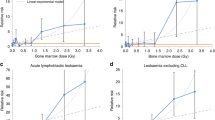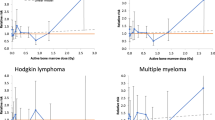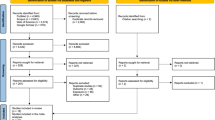Abstract
The aetiology of childhood leukaemia remains generally unknown, although exposure to moderate and high levels of ionizing radiation, such as those experienced during the atomic bombings of Japan or from radiotherapy, is an established cause. Risk models based primarily on studies of the Japanese atomic bomb survivors imply that low-level exposure to ionizing radiation, including ubiquitous natural background radiation, also raises the risk of childhood leukaemia. Using two sets of recently published leukaemia risk models and estimates of natural background radiation red-bone-marrow doses received by children, about 20% of the cases of childhood leukaemia in Great Britain are predicted to be attributable to this source. However, for one of these sets of risk models this attributable fraction is materially dependent on how the radiation-induced risk is assumed to be transferred between the Japanese atomic bomb survivors and Western children. Over a range of annual doses representing the range (0.5–2.5 mSv/year) experienced by most populations, the attributable proportion for the preferred risk-transfer model varies between 8 and 30%, with small deviations from a linear relationship that are largely due to the saturation of the model, although again this range of attributable fractions depends on the assumed transfer of risk between populations.
This is a preview of subscription content, access via your institution
Access options
Subscribe to this journal
Receive 12 print issues and online access
$259.00 per year
only $21.58 per issue
Buy this article
- Purchase on Springer Link
- Instant access to full article PDF
Prices may be subject to local taxes which are calculated during checkout
Similar content being viewed by others
References
Folley JH, Borges W, Yamawaki T . Incidence of leukemia in survivors of the atomic bomb in Hiroshima and Nagasaki, Japan. Am J Med 1952; 13: 311–321.
Committee to Assess Health Risks from Exposure to Low Levels of Ionizing Radiation. Health Risks from Exposure to Low Levels of Ionizing Radiation. BEIR VII Phase 2. The National Academies Press: Washington, DC, 2006, pp i–xvi+1–406.
United Nations Scientific Committee on the Effects of Atomic Radiation. UNSCEAR 2006 Report to the General Assembly with Scientific Annexes. Effects of Ionizing Radiation. Volume I Report and Annexes A and B. United Nations: New York, 2008, pp i–v+1–322.
Linet MS, Devesa SS, Morgan GJ . The leukemias. In: Schottenfeld D, Fraumeni Jr JF (eds). Cancer Epidemiology and Prevention, 3rd edn. Oxford University Press: New York, 2006, pp 841–871.
Greaves M . Infection, immune responses and the aetiology of childhood leukaemia. Nat Rev Cancer 2006; 6: 193–203.
Little J . Epidemiology of Childhood Cancer, IARC Scientific Publications No. 149. International Agency for Research on Cancer: Lyon, France, 1999, pp i–xiv+1–386.
Watson SJ, Jones AL, Oatway WB, Hughes JS . Ionising Radiation Exposure of the UK Population: 2005 Review. Report HPA-RPD-001. Health Protection Agency: Chilton, UK, 2005, pp i-vi+1–104.
Kendall GM, Hughes JS, Oatway WB, Jones AL . Variations in radiation exposures of adults and children in the UK. J Radiol Prot 2006; 26: 257–276.
Simmonds JR, Robinson CA, Phipps AW, Muirhead CR, Fry FA . Risks of Leukaemia and Other Cancers in Seascale from All Sources of Ionising Radiation Exposure. Report NRPB-R276. National Radiological Protection Board: Chilton, UK, 1995, pp i–viii+1–277.
International Commission on Radiological Protection. The 2007 Recommendations of the International Commission on Radiological Protection. ICRP Publication 103. Ann ICRP 2007; 37 (2–4): i-ii+1–332.
Stiller C . Childhood Cancer in Britain. Incidence, Survival, Mortality. Oxford University Press: Oxford, UK, 2007, pp i–xiii+1–270.
Preston DL, Pierce DA, Shimizu Y, Cullings HM, Fujita S, Funamoto S et al. Effect of recent changes in atomic bomb survivor dosimetry on cancer mortality risk estimates. Radiat Res 2004; 162: 377–389.
Preston DL, Kusumi S, Tomonaga M, Izumi S, Ron E, Kuramoto A et al. Cancer incidence in atomic bomb survivors. Part III. Leukemia, lymphoma and multiple myeloma, 1950–1987. [erratum in Radiat Res 1994; 139: 129] Radiat Res 1994; 137 (2 Suppl): S68–S97.
Wakeford R, Little MP . Risk coefficients for childhood cancer after intrauterine irradiation: a review. Int J Radiat Biol 2003; 79: 293–309.
International Commission on Radiological Protection. Biological effects after prenatal irradiation (embryo and fetus). ICRP Publication 90. Ann ICRP 2003; 33 (1–2): i-vi+1–200.
Committee on the Biological Effects of Ionizing Radiations. Health Effects of Exposure to Low Levels of Ionizing Radiation. BEIR V. National Academy Press: Washington, DC, 1990, pp i–xiii+1–421.
Wakeford R . The cancer epidemiology of radiation. Oncogene 2004; 23: 6404–6428.
Court Brown WM, Doll R . Leukaemia in childhood and young adult life. Trends in mortality in relation to aetiology. Br Med J 1961; 1: 981–988.
Fraumeni JF, Miller RW . Epidemiology of human leukemia: recent observations. J Natl Cancer Inst 1967; 38: 593–605.
Kato I, Tajima K, Hirose K, Nakagawa N, Kuroishi T, Tominaga S . A descriptive epidemiological study of hematopoietic neoplasms in Japan. Jpn J Clin Oncol 1985; 15: 347–364.
Parkin DM, Kramárová E, Draper GJ, Masuyer E, Michaelis J, Neglia J et al. International Incidence of Childhood Cancer, vol. II. IARC Scientific Publications No. 144. International Agency for Research on Cancer: Lyon, France, 1998, pp i–xlvii+1–453.
Ron E, Modan B, Boice Jr JD . Mortality after radiotherapy for ringworm of the scalp. Am J Epidemiol 1988; 127: 713–725.
Little MP . Leukaemia following childhood radiation exposure in the Japanese atomic bomb survivors and in medically exposed groups. Radiat Prot Dosimetry 2008 (in press), doi:10.1093/rpd/ncn264.
Lundell M, Holm L-E . Mortality from leukemia after irradiation in infancy for skin hemangioma. Radiat Res 1996; 145: 595–601.
Ronckers CM, Land CE, Verduijn PG, Hayes RB, Stovall M, van Leeuwen FE . Cancer mortality after nasopharyngeal radium irradiation in the Netherlands: a cohort study. J Natl Cancer Inst 2001; 93: 1021–1027.
Muirhead CR, Butland BK, Green BMR, Draper GJ . Childhood leukaemia and natural radiation. Lancet 1991; 337: 503–504.
Muirhead CR, Butland BK, Green BMR, Draper GJ . An analysis of childhood leukaemia and natural radiation in Britain. Radiat Prot Dosimetry 1992; 45: 657–660.
Richardson S, Monfort C, Green M, Draper G, Muirhead C . Spatial variation of natural radiation and childhood leukaemia incidence in Great Britain. Stat Med 1995; 14: 2487–2501.
UKCCS Investigators. The United Kingdom Childhood Cancer Study of exposure to domestic sources of ionising radiation: 2: gamma radiation. Br J Cancer 2002; 86: 1727–1731.
UKCCS Investigators. The United Kingdom Childhood Cancer Study of exposure to domestic sources of ionising radiation: 1: radon gas. Br J Cancer 2002; 86: 1721–1726.
Raaschou-Nielsen O, Andersen CE, Andersen HP, Gravesen P, Lind M, Schüz J et al. Domestic radon and childhood cancer in Denmark. Epidemiology 2008; 19: 536–543.
Evrard A-S, Hémon D, Billon S, Laurier D, Jougla E, Tirmarche M et al. Childhood leukemia incidence and exposure to indoor radon, terrestrial and cosmic gamma radiation. Health Phys 2006; 90: 569–579.
Tao Z, Zha Y, Akiba S, Sun Q, Zou J, Li J et al. Cancer mortality in the high background radiation areas of Yangjiang, China during the period between 1979 and 1995. J Radiat Res 2000; 41 (Suppl): 31–41.
Akiba S, Sun QF, Tao ZF, Gabgadharan P . Child cancer risk in high-background radiation areas. Int Congress Ser 2002; 1225: 283–287.
Nair MK, Nambi KSV, Amma NS, Gangadharan P, Jayalekshmi P, Jayadevan S et al. Population study in the high natural background radiation area in Kerala, India. Radiat Res 1999; 152 (Suppl): S145–S148.
Ghiassi-nejad M, Mortazavi SMJ, Cameron JR, Niroomand-rad A, Karam PA . Very high background radiation areas of Ramsar, Iran: preliminary biological studies. Health Phys 2002; 82: 87–93.
International Commission on Radiological Protection. Age-dependent doses to members of the public from intake of radionuclides. Part 1. ICRP Publication 56. Ann ICRP 1989; 20 (2): 1–122.
International Commission on Radiological Protection. Age-dependent doses to members of the public from intake of radionuclides. Part 2. Ingestion dose coefficients. ICRP Publication 67. Ann ICRP 1993; 23 (3–4): 1–167.
International Commission on Radiological Protection. Doses to the embryo and fetus from intakes of radionuclides by the mother. ICRP Publication 88. Ann ICRP 2001; 31 (1–3): 1–518.
Kendall GM, Smith TJ . Doses from radon and its decay products to children. J Radiol Prot 2005; 25: 241–256.
Acknowledgements
We are grateful to TJ Vincent for supplying cancer incidence data, and for many helpful comments from Dr Bernd Grosche and the four referees. This work was funded partially by the European Commission under contract FI6R-CT-2003-508842 (RISC-RAD).
Author information
Authors and Affiliations
Corresponding author
Additional information
Supplementary Information accompanies the paper on the Leukemia website (http://www.nature.com/leu)
Supplementary information
Rights and permissions
About this article
Cite this article
Wakeford, R., Kendall, G. & Little, M. The proportion of childhood leukaemia incidence in Great Britain that may be caused by natural background ionizing radiation. Leukemia 23, 770–776 (2009). https://doi.org/10.1038/leu.2008.342
Received:
Revised:
Accepted:
Published:
Issue Date:
DOI: https://doi.org/10.1038/leu.2008.342
Keywords
This article is cited by
-
Radiation dose rate effects: what is new and what is needed?
Radiation and Environmental Biophysics (2022)
-
Childhood cancer research in oxford III: The work of CCRG on ionising radiation
British Journal of Cancer (2018)
-
Radiation-induced myeloid leukemia in murine models
Human Genomics (2014)
-
The risk of leukaemia in young children from exposure to tritium and carbon-14 in the discharges of German nuclear power stations and in the fallout from atmospheric nuclear weapons testing
Radiation and Environmental Biophysics (2014)
-
A record-based case–control study of natural background radiation and the incidence of childhood leukaemia and other cancers in Great Britain during 1980–2006
Leukemia (2013)



